Europe Electric Vehicle Battery Materials Market Size
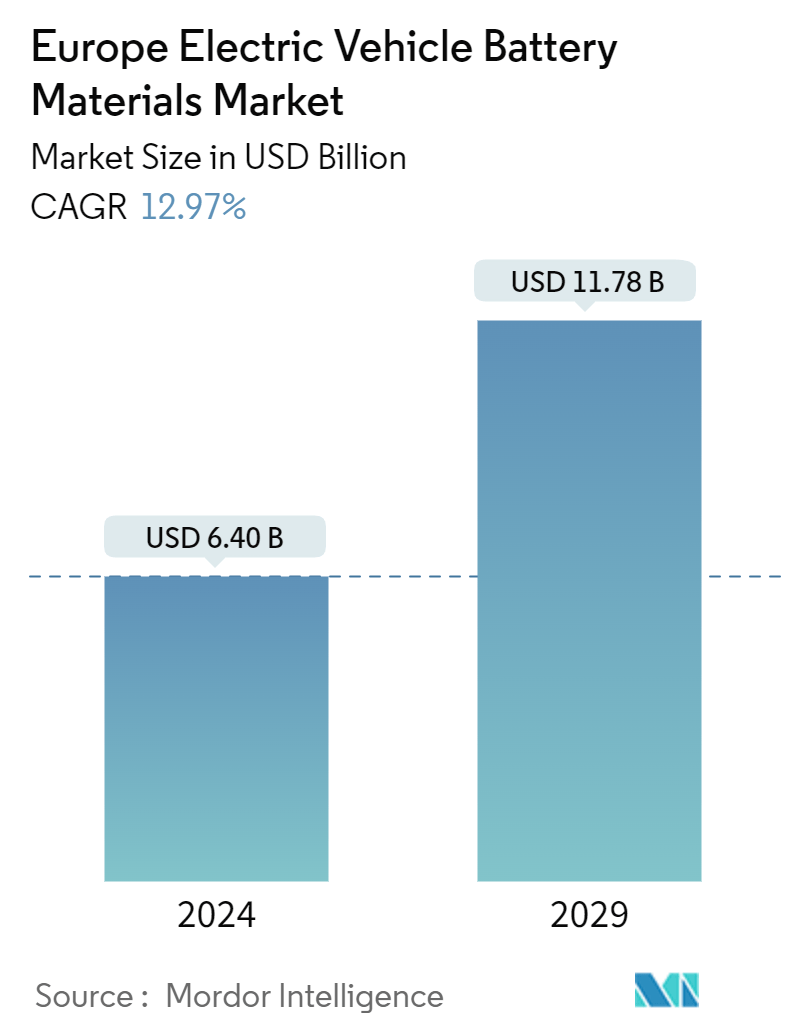
| Study Period | 2019 - 2029 |
| Base Year For Estimation | 2023 |
| Market Size (2024) | USD 6.40 Billion |
| Market Size (2029) | USD 11.78 Billion |
| CAGR (2024 - 2029) | 12.97 % |
| Market Concentration | Medium |
Major Players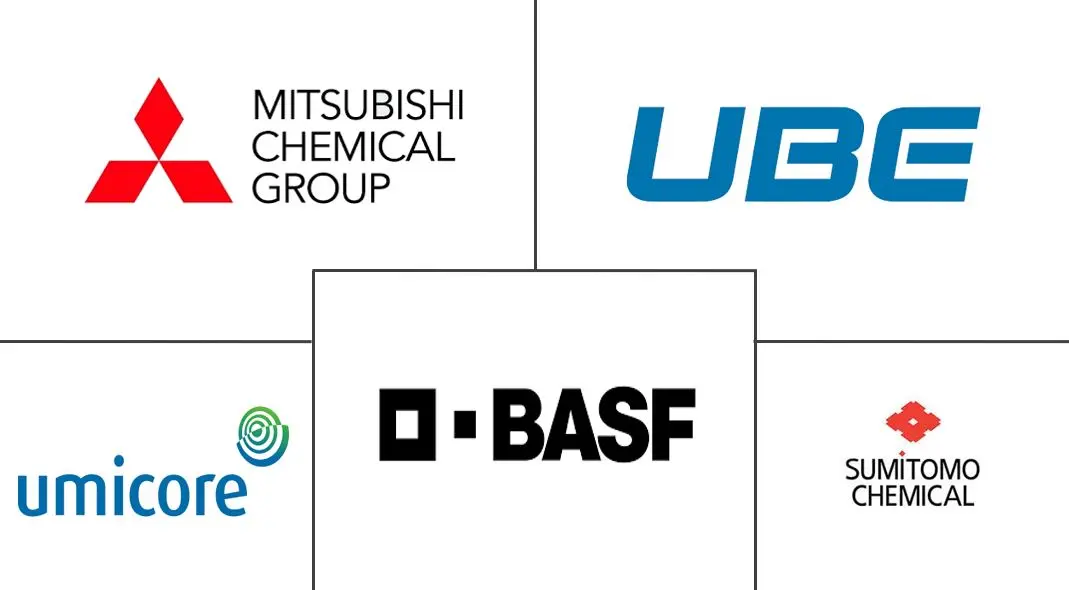
*Disclaimer: Major Players sorted in no particular order |
Europe Electric Vehicle Battery Materials Market Analysis
The Europe Electric Vehicle Battery Materials Market size is estimated at USD 6.40 billion in 2024, and is expected to reach USD 11.78 billion by 2029, at a CAGR of 12.97% during the forecast period (2024-2029).
- Over the medium term, growing electric vehicle (EV) sales and supportive government policies and regulations are expected to drive the demand for electric vehicle battery materials during the forecast period.
- On the other hand, the high import dependency on battery materials and the impact on the supply chain are likely to negatively impact the market.
- However, as batteries evolve with advancements like enhanced energy density, quicker charging, heightened safety, and extended lifespans, significant opportunities emerge for players in the electric vehicle battery materials market.
- Driven by a surge in electric vehicle adoption, Germany is poised to lead as the fastest-growing region in Europe's electric vehicle battery materials market.
Europe Electric Vehicle Battery Materials Market Trends
Lithium-Ion Battery Type Dominate the Market
- The production of lithium-ion batteries for electric vehicles (EVs) is on the rise, significantly influencing the battery materials market. This surge in production has driven up the demand for lithium, and discoveries of lithium in the region are notably affecting raw material costs.
- Key market players are channeling investments into lithium reserves and R&D, aiming to boost lithium-ion battery production and meet the growing demand for battery raw materials. As new reserves are discovered, the prices of lithium-ion batteries have seen a downward trend over time.
- For instance, in 2023, battery prices for electric vehicles (EVs) and battery energy storage systems (BESS) dropped to USD 139/kWh, marking a decline of over 13%. With ongoing technological innovations and manufacturing improvements, projections suggest prices will further dip to USD 113/kWh by 2025 and reach USD 80/kWh by 2030.
- Moreover, European governments are actively promoting lithium-ion battery production for EVs, driven by mounting environmental concerns. With a keen focus on achieving net-zero carbon emissions, these governments have launched multiple initiatives to boost lithium-ion battery production, aiming to meet the surging EV demand.
- For instance, in November 2023, the United Kingdom government unveiled a GBP 50 million (USD 63 million) investment to fortify its battery supply chain, including lithium-ion batteries, aligning with the nation's future EV production goals. The Battery Strategy promises focused support for zero-emission vehicles and their supply chains, with new capital and R&D funding extending to 2030. Such initiatives are poised to bolster the adoption of lithium-ion batteries as a clean energy source, subsequently driving up the demand for battery materials.
- Additionally, as lithium-ion battery prices decline and demand surges, the establishment of new production plants further fuels the need for battery raw materials. Recent years have witnessed a significant uptick in investments aimed at boosting lithium-ion battery production.
- For instance, in February 2024, France unveiled a EUR 10 billion (USD 10.84 billion) investment, sourced from both public and private entities, to establish four gigafactories for electric vehicle batteries, including lithium-ion variants, across the nation in the upcoming years. Such strategic investments are set to amplify battery production in France, subsequently heightening the demand for lithium-ion battery materials.
- Given these advancements and initiatives, a marked increase in lithium-ion battery production and a surge in demand for EV battery materials are anticipated during the forecast period.
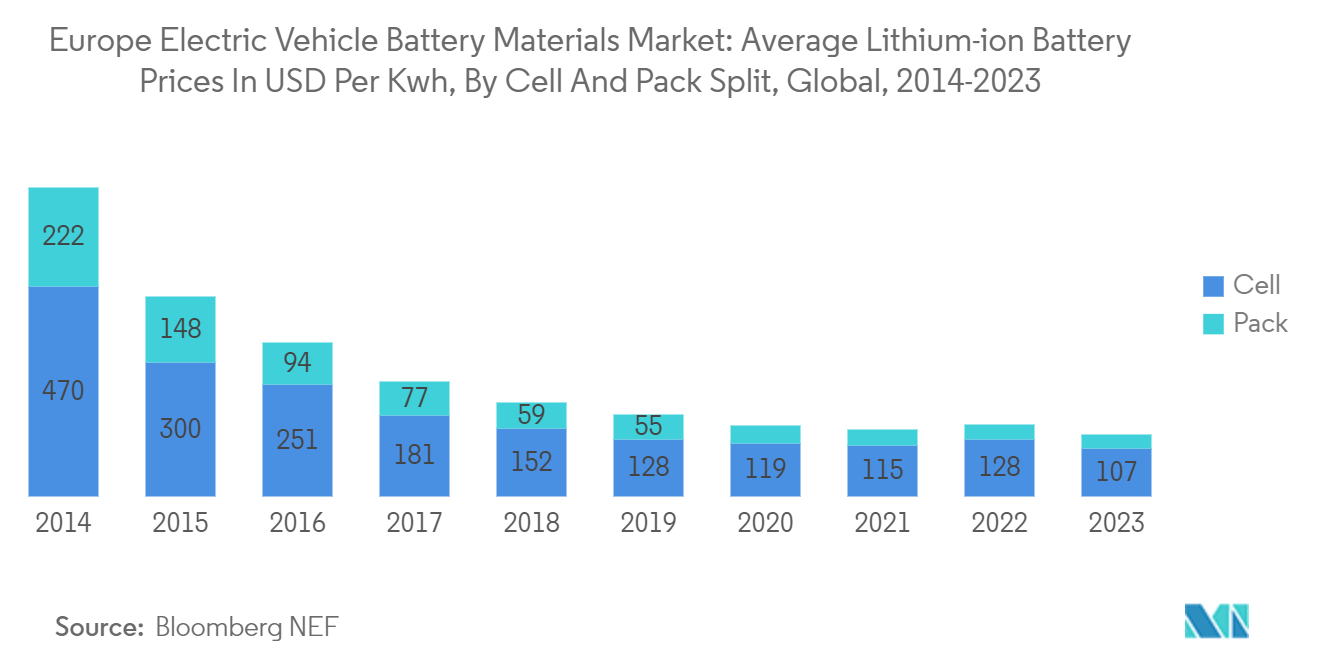
Germany to Witness Significant Growth
- Germany plays a significant role in the electric vehicle (EV) battery materials sector, driven by its automotive industry and commitment to sustainable mobility. In the past few years, the country has become one of the leading EV producers across the region.
- According to the International Energy Agency (IEA), Electric vehicle (EV) sales in Germany reached 0.7 million units in 2023, consistent with 2022 figures but marking a 5.5-fold increase since 2019. With numerous projects and initiatives recently launched by the European government, EV sales are poised for significant growth in the coming years.
- Germany plays a pivotal role in the European Battery Alliance, which aims to establish a competitive and sustainable battery cell manufacturing value chain in Europe. Collaborating closely with leading EV companies, the German government is making substantial investments in domestic battery cell production facilities.
- In January 2024, Northvolt, a Swedish lithium-ion battery manufacturer, secured European Union approval for a significant EUR 902 million (USD 986.43 million) state aid package. This funding is earmarked for establishing an EV and hybrid vehicle battery production plant in Heide, Germany. Such moves are set to boost battery production in the region, driving up demand for EV battery materials.
- Germany is leading the charge in advanced battery recycling technologies. Both companies and research institutions are innovating efficient methods to extract valuable materials, such as lithium, cobalt, and nickel, from used batteries.
- In May 2024, Elemental Strategic Metals (ESM), a Polish firm, in collaboration with its US start-up partner Ascend Elements, unveiled plans for a lithium-ion battery recycling plant. With a capacity of 25,000 tonnes per year, construction is slated for autumn 2024, aiming for operational status by 2026. Such ventures are set to boost raw material production, further elevating the output of EV battery materials.
- Given these developments, the trajectory points towards heightened battery production for EVs and a marked surge in demand for EV battery materials in the forecast period.
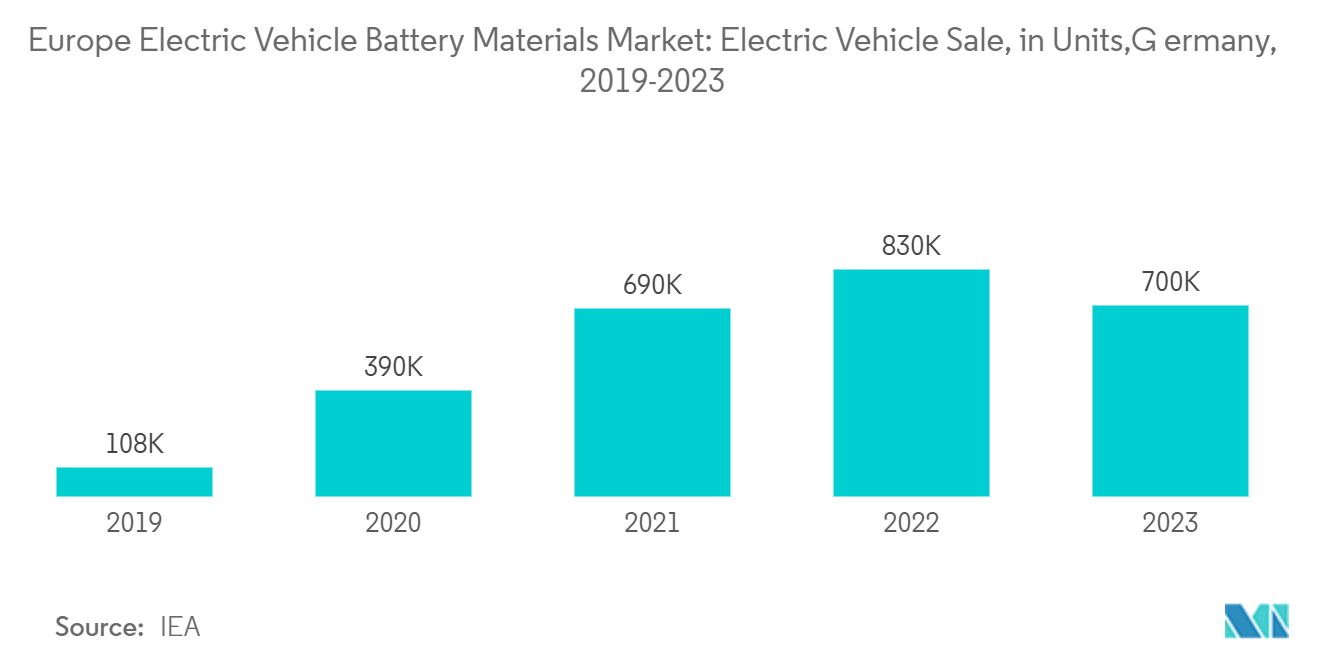
Europe Electric Vehicle Battery Materials Industry Overview
Europe's electric vehicle battery materials market is moderately fragmented. Some key players (not in particular order) are BASF SE, Mitsubishi Chemical Group Corporation, UBE Corporation, Umicore, Sumitomo Chemical Co., Ltd., among others.
Europe Electric Vehicle Battery Materials Market Leaders
-
Sumitomo Chemical Co., Ltd.
-
Mitsubishi Chemical Group Corporation
-
Umicore
-
UBE Corporation
-
BASF SE
*Disclaimer: Major Players sorted in no particular order
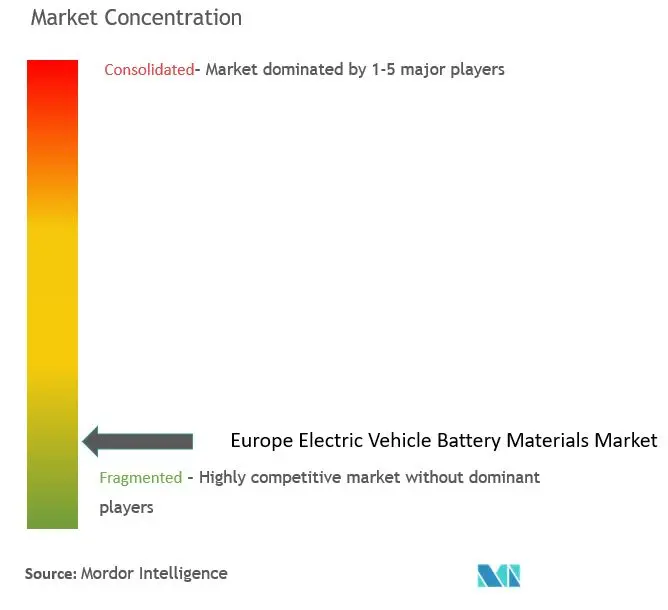
Europe Electric Vehicle Battery Materials Market News
- March 2024: the European Union signed a deal with Norway to develop sustainable land-based raw materials and battery value chains with a capital investment of USD 26 million. The strategic partnership on battery materials is likely to develop a comprehensive framework for long-term cooperation in five areas, from the battery supply chain for EVs.
- January 2024: EIT InnoEnergy and Demeter Investment Managers announced the launch of a fund dedicated to developing a resilient and diverse battery raw material supply chain in Europe. With a target size of EUR 500 million (USD 544.5 million), the EBA Strategic Battery Materials Fund is building to boost domestic capacities for EV battery materials such as lithium, nickel, cobalt, manganese, and graphite.
Europe Electric Vehicle Battery Materials Market Report - Table of Contents
1. INTRODUCTION
1.1 Scope of the Study
1.2 Market Definition
1.3 Study Assumptions
2. EXECUTIVE SUMMARY
3. RESEARCH METHODOLOGY
4. MARKET OVERVIEW
4.1 Introduction
4.2 Market Size and Demand Forecast in USD billion, till 2029
4.3 Recent Trends and Developments
4.4 Government Policies and Regulations
4.5 Market Dynamics
4.5.1 Drivers
4.5.1.1 Growing Electric Vehicle Sales
4.5.1.2 Supportive Government Policies and Regulations
4.5.2 Restraints
4.5.2.1 Dependency on Imported Raw Material Supply
4.6 Supply Chain Analysis
4.7 Industry Attractiveness - Porter's Five Forces Analysis
4.7.1 Bargaining Power of Suppliers
4.7.2 Bargaining Power of Consumers
4.7.3 Threat of New Entrants
4.7.4 Threat of Substitutes Products and Services
4.7.5 Intensity of Competitive Rivalry
4.8 Investment Analysis
5. MARKET SEGMENTATION
5.1 Battery Type
5.1.1 Lithium-ion Battery
5.1.2 Lead-Acid Battery
5.1.3 Others
5.2 Material
5.2.1 Cathode
5.2.2 Anode
5.2.3 Electrolyte
5.2.4 Separator
5.2.5 Others
5.3 Geography
5.3.1 Germany
5.3.2 France
5.3.3 United Kingdom
5.3.4 Italy
5.3.5 Spain
5.3.6 Russia
5.3.7 Turkey
5.3.8 NORDIC
5.3.9 Rest of Europe
6. COMPETITIVE LANDSCAPE
6.1 Mergers and Acquisitions, Joint Ventures, Collaborations, and Agreements
6.2 Strategies Adopted by Leading Players
6.3 Company Profiles
6.3.1 Sumitomo Chemical Co., Ltd.
6.3.2 BASF SE
6.3.3 Mitsubishi Chemical Group Corporation
6.3.4 UBE Corporation
6.3.5 Umicore SA
6.3.6 Contemporary Amperex Technology Co. Limited
6.3.7 Johnson Matthey
6.3.8 ENTEK International LLC
6.3.9 Northvolt
6.3.10 SGL Carbon
6.4 List of Other Prominent Companies
6.5 Market Ranking/ Share Analysis
7. MARKET OPPORTUNITIES AND FUTURE TRENDS
7.1 Advancements in Battery Technology
Europe Electric Vehicle Battery Materials Industry Segmentation
Electric vehicle (EV) battery materials refer to the raw materials and compounds used in the manufacturing of batteries specifically designed for electric vehicles. These materials are critical for the performance, energy density, lifespan, and safety of EV batteries.
Europe's electric vehicle battery materials market is Segmented by Battery Type, Material, and Geography. By battery type, the market is segmented into Lithium-Ion Battery, Lead-Acid Battery, and Others. By materials, the market is segmented into Cathode, Anode, Electrolyte, Separator, and Others. The report also covers the market size and forecasts for Europe's electric vehicle battery materials market across major countries. The Report Offers the Market Size and Forecasts in Revenue (USD) for all the Above.
| Battery Type | |
| Lithium-ion Battery | |
| Lead-Acid Battery | |
| Others |
| Material | |
| Cathode | |
| Anode | |
| Electrolyte | |
| Separator | |
| Others |
| Geography | |
| Germany | |
| France | |
| United Kingdom | |
| Italy | |
| Spain | |
| Russia | |
| Turkey | |
| NORDIC | |
| Rest of Europe |
Europe Electric Vehicle Battery Materials Market Research FAQs
How big is the Europe Electric Vehicle Battery Materials Market?
The Europe Electric Vehicle Battery Materials Market size is expected to reach USD 6.40 billion in 2024 and grow at a CAGR of 12.97% to reach USD 11.78 billion by 2029.
What is the current Europe Electric Vehicle Battery Materials Market size?
In 2024, the Europe Electric Vehicle Battery Materials Market size is expected to reach USD 6.40 billion.
Who are the key players in Europe Electric Vehicle Battery Materials Market?
Sumitomo Chemical Co., Ltd., Mitsubishi Chemical Group Corporation, Umicore, UBE Corporation and BASF SE are the major companies operating in the Europe Electric Vehicle Battery Materials Market.
What years does this Europe Electric Vehicle Battery Materials Market cover, and what was the market size in 2023?
In 2023, the Europe Electric Vehicle Battery Materials Market size was estimated at USD 5.57 billion. The report covers the Europe Electric Vehicle Battery Materials Market historical market size for years: 2019, 2020, 2021, 2022 and 2023. The report also forecasts the Europe Electric Vehicle Battery Materials Market size for years: 2024, 2025, 2026, 2027, 2028 and 2029.
Europe Electric Vehicle Battery Materials Industry Report
Statistics for the 2024 Europe Electric Vehicle Battery Materials market share, size and revenue growth rate, created by Mordor Intelligence™ Industry Reports. Europe Electric Vehicle Battery Materials analysis includes a market forecast outlook for 2024 to 2029 and historical overview. Get a sample of this industry analysis as a free report PDF download.

